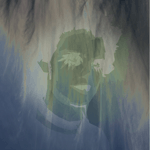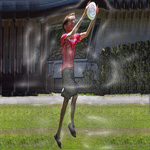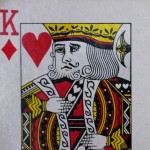I do not expect a theory of personhood to match all our pre-reflective philosophical intuitions, even if deeply considered and strongly felt (especially if strongly felt!) for two reasons: (1) our best intuitions on this subject are demonstrably unreliable, and (2) billions of otherwise sane and competent people hold beliefs about personal identity which are unsupported by empirical evidence, but to which they have strong emotional attachment. These two facts strongly suggest that there is something wrong with what we are naively inclined to believe about our identity. Hence we should not be surprised to find that a satisfactory solution, when it is found, will at first seem counter-intuitive. Continue reading “Towards a Scientific Theory of Persons”
A Special Form of Darkness: Metzinger on Subjectivity
O ur brains represent ourselves, to ourselves, by means of a Phenomenal Self-Model (PSM). According to Thomas Metzinger, the PSM is characterized by transparency, and a phenomenal quality of ‘mineness.’ Its transparency consists in our unawareness of it as a model. We look and act ‘right through it’ – we take our models for our real selves. ‘Mineness’ is a quality that infuses all of our experience which we take to be experience of ourselves. Although Metzinger uses the terms “mineness” and “ownership,” it is more than an experience of ownership. I think “me-ness” aptly captures what Metzinger is after. Continue reading “A Special Form of Darkness: Metzinger on Subjectivity”
ur brains represent ourselves, to ourselves, by means of a Phenomenal Self-Model (PSM). According to Thomas Metzinger, the PSM is characterized by transparency, and a phenomenal quality of ‘mineness.’ Its transparency consists in our unawareness of it as a model. We look and act ‘right through it’ – we take our models for our real selves. ‘Mineness’ is a quality that infuses all of our experience which we take to be experience of ourselves. Although Metzinger uses the terms “mineness” and “ownership,” it is more than an experience of ownership. I think “me-ness” aptly captures what Metzinger is after. Continue reading “A Special Form of Darkness: Metzinger on Subjectivity”
Metzinger: Being No One
 Being No One is a substantial work by German philosopher Thomas Metzinger about “consciousness, the phenomenal self, and the first-person perspective.” Its main thesis “is that no such things as selves exist in the world. Nobody ever was or had a self.”
Being No One is a substantial work by German philosopher Thomas Metzinger about “consciousness, the phenomenal self, and the first-person perspective.” Its main thesis “is that no such things as selves exist in the world. Nobody ever was or had a self.”
I have spent some time with the book, making, from its 634 densely-printed pages, 104 pages of notes. After all that, I still question Metzinger’s ‘main thesis.’ But I have no doubts about the value of the book. It irrevocably raises the standard for what philosophy of mind must explain. In its early pages, Metzinger echoes Paul Churchland’s complaint, that “theoretical approaches to the mental, still intuitively rooted in folk psychology, have generated very little growth of knowledge in the last twenty-five centuries.” Being No One goes a long way towards burying that era. Continue reading “Metzinger: Being No One”
The Plastic Self
 Neurologists have demonstrated plasticity in the spatial sense of self, or body-image. Not only are the ‘phantom limbs’ of amputees somewhat malleable, under special circumstances (and also remarkably intractable under others), but we can be induced to perceive a detached rubber hand, lying on a table, as our own hand, and even to feel that the table-top itself is part of our own body. But how plastic, if at all, are our ideas of ourselves extended into the future and the past?
Neurologists have demonstrated plasticity in the spatial sense of self, or body-image. Not only are the ‘phantom limbs’ of amputees somewhat malleable, under special circumstances (and also remarkably intractable under others), but we can be induced to perceive a detached rubber hand, lying on a table, as our own hand, and even to feel that the table-top itself is part of our own body. But how plastic, if at all, are our ideas of ourselves extended into the future and the past?
Published in 1970, Bernard Williams’ “The Self and the Future” is one of the seminal papers that gave rise to the contemporary philosophical debate on personal identity. Williams presents two series of thought-experiments, which lead his own intuitions in opposite directions on the question whether a future person, described as having a certain relationship to his present self, would be himself or someone else. One set of cases tends to persuade him that what matters in personal identity – the relation that makes us the same person over time – is psychological continuity. The other set of cases makes him think that bodily continuity is more important. Williams reports being left “not in the least clear” which is right.
Williams presents this as a philosophical problem. I suggest it is more fruitfully regarded as an experimental result – a single data-point in a psychological experiment, with Williams as both subject and experimenter. If repeated with a larger, and less contaminated, sample population, such an experiment could shed the light of empirical research on the question with which I opened this post. I hope someone will undertake such a study, which could lead in interesting directions. Continue reading “The Plastic Self”
The Phantom Neuroscientist
 In recent weeks, I have been devouring V.S. Ramachandran’s books and videos on what can be learned about the brain by studying patients with neurological damage. To clarify my title, Ramachandran is not a phantom himself, but a doctor of phantoms – actually a ‘phantom-buster’. He is famous for curing phantom-limb syndrome – an amputee’s stubborn, often debilitating, physical awareness of a limb that has been surgically removed – by an amazingly simple, low-tech trick with mirrors.
In recent weeks, I have been devouring V.S. Ramachandran’s books and videos on what can be learned about the brain by studying patients with neurological damage. To clarify my title, Ramachandran is not a phantom himself, but a doctor of phantoms – actually a ‘phantom-buster’. He is famous for curing phantom-limb syndrome – an amputee’s stubborn, often debilitating, physical awareness of a limb that has been surgically removed – by an amazingly simple, low-tech trick with mirrors.
The ‘Phantom-Buster’ Mirror Trick
One of Ramachandran’s patients was desperate for relief from pain in his phantom arm, which he felt to be cramped and paralyzed. As described in A Brief Tour of Human Consciousness:
We propped up a mirror vertically on a table…so that it was at right angles to his chest, and asked him to position his paralyzed phantom left arm on the left of the mirror and mimic its posture with his right hand, which was on the right side of the mirror. We then asked him to look into the right-hand side of the mirror so that he saw the mirror reflection of his intact hand optically superimposed on the felt location of the phantom. We then asked him to try to make symmetrical movements of both hands, such as clapping or conducting an orchestra, while looking in the mirror. Imagine his amazement and ours when suddenly he not only saw the phantom move but felt it move as well.

